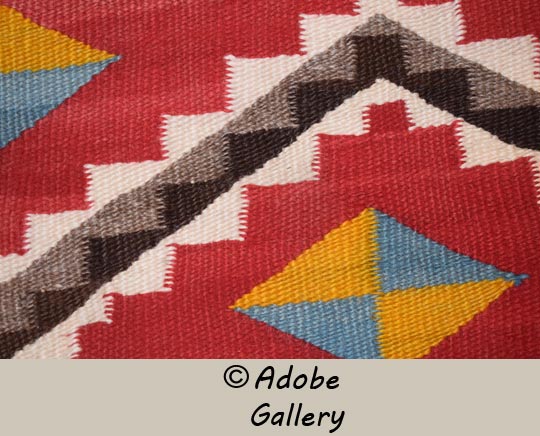Ganado Red Navajo Rug [SOLD]
+ Add to my watchlist Forward to Friend
- Category: Navajo Textiles
- Origin: Diné of the Navajo Nation
- Medium: wool, dyes
- Size: 57” x 36”
- Item # C4775E SOLD
Weaving, a cherished art form in the Southwest, is a long-held tradition among the Navajo people. For at least 150 years, Navajo textiles have been highly sought by both Natives and consumers alike.
This Navajo rug is estimated to date back to around the 1930s. It is likely from the famous Ganado Trading Post area, and its overall color is a rich red, perhaps the most well-known color of all Navajo rugs, referred to universally as "Ganado Red". The color scheme and design are unique and exciting. Woven into the rug are many traditional geometric Navajo patterns, colored in black, gray, white, yellow, and turquoise.
The rug was woven from churro wool and dyed in various lots of aniline red dye. The various dye lots are evident throughout the textile. This is a classic way to determine whether the wool was hand dyed or commercially dyed. Churro sheep produced spectacular wool for weaving. Fortunately, some of the weavers had churro sheep during the period of this textile. Earlier, around 1910, the government, with the intent of increasing meat production for the tribe, issued large flocks of French Rambouillet sheep to the Diné. The Rambouillet sheep were good for mutton and fleece, but terrible for weaving. It was short and oily, difficult to clean, card, spin, and weave. Those women who still had churro sheep were fortunate.
The patterns on the rug include symmetrical lines on both the bottom and the top, three zigzag patterns equally spaced, each surrounded by squares featuring four triangles within, and two equally spaced bands in the middle of the rug of beige, black, and white colors. The patterns within the bands are of a diamond-symmetrical motif.
Juan Lorenzo Hubbell, trader at Ganado Trading Post, "became the best-known trader in the Southwest as well as the one who had the greatest early influence on the development of the twentieth-century regional-style Navajo rug. . . Hubbell encouraged the weavers who lived in the Ganado area to produce high-quality weavings in a very effective way: he refused to buy any weavings that did not meet his standards. He also insisted that weavers use a double portion of red dye so that the hand-spun yarn would be a uniquely strong red color." [Selser 1985:69]
A special piece of history, this magnificently designed Navajo textile will make a fantastic addition to any passionate collection.
Condition: very good condition, especially considering its age. It should be noted that there are two minor soils on the rug but neither appear on either side so this indicates that they may be able to be easily removed.
Provenance: this Ganado Red Navajo Rug is from the collection of a gentleman from California
Recommended Reading: The Navajo Weaving Tradition: 1650 to the Present by Alice Kaufman and Christopher Selser
TAGS: textiles, Navajo Nation

- Category: Navajo Textiles
- Origin: Diné of the Navajo Nation
- Medium: wool, dyes
- Size: 57” x 36”
- Item # C4775E SOLD
Adobe Gallery Recommended Reading
Adobe Gallery Recommended Items
If you are interested in this item, we would also like to recommend these other related items:



